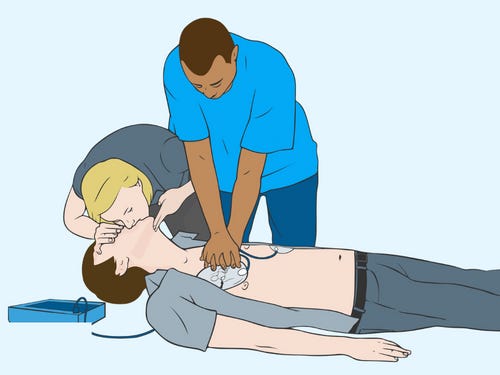How to Give CPR
Written by Aarushi Rai
CPR, or cardiopulmonary resuscitation, is a lifesaving procedure that many people now are learning or taking classes to do so. It is done to essentially help restart the heart of a person who has gone into cardiac arrest. This article will focus on summarizing CPR, although more research should be done to master it so that more people in the world will be educated on how to conduct it. Also, note that infant and child CPR may be different from this procedure and needs its own training.
If a person appears unresponsive, such as if they collapse, are not breathing, or do not have a pulse, then the first thing you should do is loudly yell at the person to ask if they are okay. If they are not responding, check the scene for safety, call 911 to get help, and ask someone to get an AED (automated external defibrillator). Next, kneel beside the person and place them on their back somewhere flat and firm, then tilt their head back and listen for breathing. If they are breathing, check for a pulse, and if you do not feel one, then move on to perform CPR.
Put one hand over the other, centered on the middle of the chest, and position your body so that your shoulders are directly over your hands and your elbows are locked. Next, push your hands hard into the person’s chest, putting the force of your body weight into it. At a rate of 100 to 120 times per minute, give at least 30 chest compressions. The point of chest compressions is to keep blood flowing to the vital organs until the person’s regular heartbeat returns. It is important to make sure that the chest is allowed to come back up between compressions.
If you have the CPR training to do so, you can pause compressions to give two rescue breaths every 30 compressions. To do so, pinch the person’s nose closed and tilt their head back and chin up. Using mouth-to-mouth, blow a normal-sized breath into their mouth that lasts about 1 second and makes their chest rise. Lastly, allow their air to exit out before giving the next breath. There should be 2 breaths given, and then go back to doing compressions. As soon as it is available, use an AED until an ambulance arrives.
References
American Red Cross Training Services. (n.d.). CPR steps | How to perform CPR | Red Cross. Red Cross. https://www.redcross.org/take-a-class/cpr/performing-cpr/cpr-steps
Professional, C. C. M. (2024, May 1). CPR. Cleveland Clinic. https://my.clevelandclinic.org/health/treatments/17680-cardiopulmonary-resuscitation-cpr


